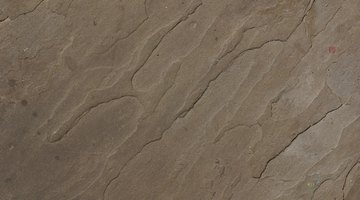How to Bond Sandstone
Sandstone is a sedimentary rock consisting of sand grain, silica, iron oxide or calcite. Sandstone is used for flooring, wall cladding, tiles, pillar caps, fireplace stones and has many other applications in decorative and functional construction.

Pieces of sandstone used in construction, while porous, are hard enough to be used as floors, patios and walkways. Sandstone can bond to many surfaces. Some applications require specific materials and procedures to ensure a lasting hold.
Things You Will Need
- Wire brush
- Plastic-bristle brush
- De-greasing agent
- Water
- Rag
- Portland cement
- Sand
- Screed
- Plastic cross-shaped separators
- Trowel
- Two-part epoxy
- Tube of acrylic or polyester adhesive
- Utility knife
- Caulking gun
Tip
When using two-part epoxies, mix the adhesive in small batches to cut down on waste product.
Warning
Wear a respirator if using epoxy, acrylic or polyester adhesives indoors.
Cement and Mortar
-
Sandstone pavers and patio tiles are usually bonded with a cement mixture. Concrete mortar is also applied to areas where sandstone is bonded to metal mesh or uneven surfaces. Clean the surface of the stone thoroughly to remove any oil, dust and dirt using the metal and plastic brushes, de-greasing agent, water and the rag. Soak the stone in water to seal its pores prior to installation.
-
Spread your cement mixture on the area to which the stone will be bonded. Mix the appropriate amount of mortar by combining one part Portland cement and three parts sand. Lime is not recommended in cement mixtures when working with sandstone. Spread the concrete evenly over the surface with a screed.
-
Lay the blocks or tiles of sandstone in the desired order and position. Use plastic separators at the corners of each block if you want a line between them. Using a trowel, fill the lines between the stones with concrete. Remove excess cement with the trowel.
Epoxy, Acrylic and Polyester Adhesives
-
Sandstone is often used for wall cladding due to the natural fluctuations it exhibits at its surface. Wall cladding is bonded vertically with its backing and needs a strong, fast-drying adhesive to secure it in place. Rough the back surface of the stone with the metal brush to increase adhesive strength. Clean the surface of the stone thoroughly to remove any oil, dust and dirt using the plastic brush, de-greasing agent, water and the rag. Allow the stone to dry completely.
-
Two-part epoxies are made by mixing an epoxy resin and a hardening agent. Mix the two ingredients and spread a generous amount of the mixture onto the back surface of the stone. Push the stone into position. If you’re using an acrylic or polyester bonding agent, cut its tube with a diagonal slit ½-inch from the top using a utility knife. Load it into a caulking gun. Apply thick beads of adhesive to the backside of the stone and press it into position.
-
Hold the stone in place for the recommended time on the manufacturer’s label to ensure a strong bond.
The Drip Cap
- Sandstone is a sedimentary rock consisting of sand grain, silica, iron oxide or calcite.
- Sandstone is often used for wall cladding due to the natural fluctuations it exhibits at its surface.
- Clean the surface of the stone thoroughly to remove any oil, dust and dirt using the plastic brush, de-greasing agent, water and the rag.
- Allow the stone to dry completely.
- Load it into a caulking gun.
References
Resources
Writer Bio
Agustus Miller has been living and writing professionally in Brooklyn, N.Y., since 2005. He has contributed to publications such as "The Brooklyn Star" and Mountain Xpress. Miller holds a Bachelor of Arts in English literature and creative writing from the University of North Carolina.
Photo Credits
- Photos.com/Photos.com/Getty Images
- Photos.com/Photos.com/Getty Images
More Articles



